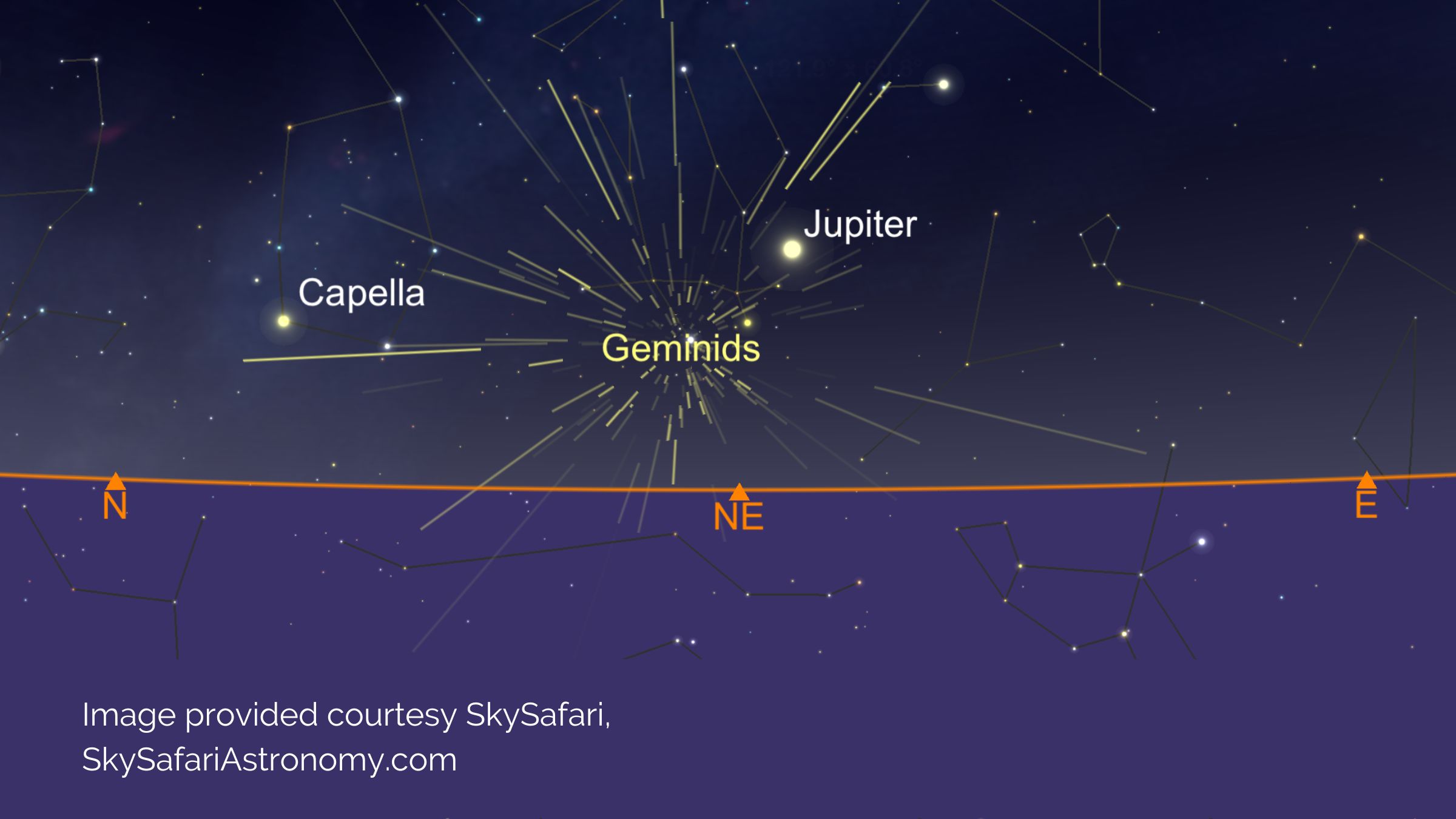The Geminids meteor shower is generated from asteroid 3200 Phaethon and is one of the most active and best meteor showers to see. Since the asteroid’s discovery on 11th October 1983, by NASA’s Infrared Astronomical Satellite (IRAS), Phaethon has gone around the sun nearly 24 times. Phaethon is 5.1kms across and is one of the largest near-Earth asteroids classified as “potentially hazardous” by NASA. Astronomers have closely monitored this asteroid and there is no high threat level in the foreseeable future.
Take a virtual tour to see how the Geminids Meteor Shower is generated with this terrific 3D interactive model.
Is it worth getting out of bed for?
Yes, it is! However, the Moon will rise at 1.10am on the morning of 15th December, so make sure to be out viewing the Geminids before this time.
When and where to look:
The peak of about 120 meteors/hour is from 11pm on 14th December. Viewing is from the north east and north about 20-45 degrees above the horizon. Keep an eye out for Jupiter which is also in the same area of sky. Nights either side of the peak are worth trying as well. The Geminids Meteor Shower is active from 4th to 17th December.
There is a bit of moonlight that may impact the viewing of this year’s Geminids. The Moon will rise at 1.10am (AWST) on 15th December, so viewing prior to this will be best. The Moon is less bright the next night which could improve viewing.
Use the above image as a guide. Astronomical images provided by SkySafari, a Simulation Curriculum Company, All rights reserved www.simulationcurriculum.com.
What is a meteor shower?
A meteor (commonly called a “shooting star”) is an unexpected, brief streak of light seen in our night sky. It’s caused when space debris, travelling up to 75km per second, enters Earth’s atmosphere. The debris can be as small as a grain of sand which burns up in the atmosphere and causes a bright streak of light to appear briefly in our night sky.
A meteor shower is a celestial spectacle where large numbers of meteors, or “shooting stars”, streak across the night sky. These dazzling events occur when Earth passes through the the trail of debris left by a comet or other object that has come into our Solar System and orbited around the Sun. Visible to the naked eye, meteor showers offer a mesmerizing display of bright streaks, adding a touch of cosmic wonder to the night.
Where’s the best place to see the meteor shower?
The best place to see a meteor shower is away from bright city lights and when the night sky is dark with no moonlight. Bright moonlight and light pollution makes it harder to see fainter meteors, however you may still be able to see the brighter ones.
Travel out to a dark sky location at one of WA’s Astrotourism Towns. If you’re an astrophotographer, it is an excellent opportunity to image meteors over some of WA’s iconic landscapes. Where are WA’s Astrotourism Towns?
You don’t need a telescope or binoculars to see a meteor shower. It’s a great time to gather with friends, roll out your favourite picnic rug, pack the drinks and snacks, and start counting how many “shooting stars” you all see! The predicted hourly rate of meteors presumes you’re viewing them in a perfectly dark sky and that the shower is directly overhead. Fingers crossed for a spectacular show!
Something interesting
Meteor showers are named after the constellation where the “shooting stars” appear to be coming from. In the case of the Geminids Meteor Shower, the meteors come from the direction of the constellation of Gemini. If you have a handy smart phone app that helps you identify objects in the night sky, search for the constellation, and you’ll be looking in the right direction.
You might like to…
Become a citizen scientist and report meteor sightings! If you happen to see a very bright meteor (often referred to as a “fireball”), WA’s fireballs team based at Curtin University would love to know! Report your fireball sighting with the International Meteor Organization.
The International Meteor Organization is a great place to discover more about all things meteors. Check out their Meteor Shower Calendar. You might even like to become a member!
Where's the Best Place to see a Meteor Shower?
You need a good dark night sky for the best view! Choose an Astrotourism Town destination. Happy meteor hunting!

